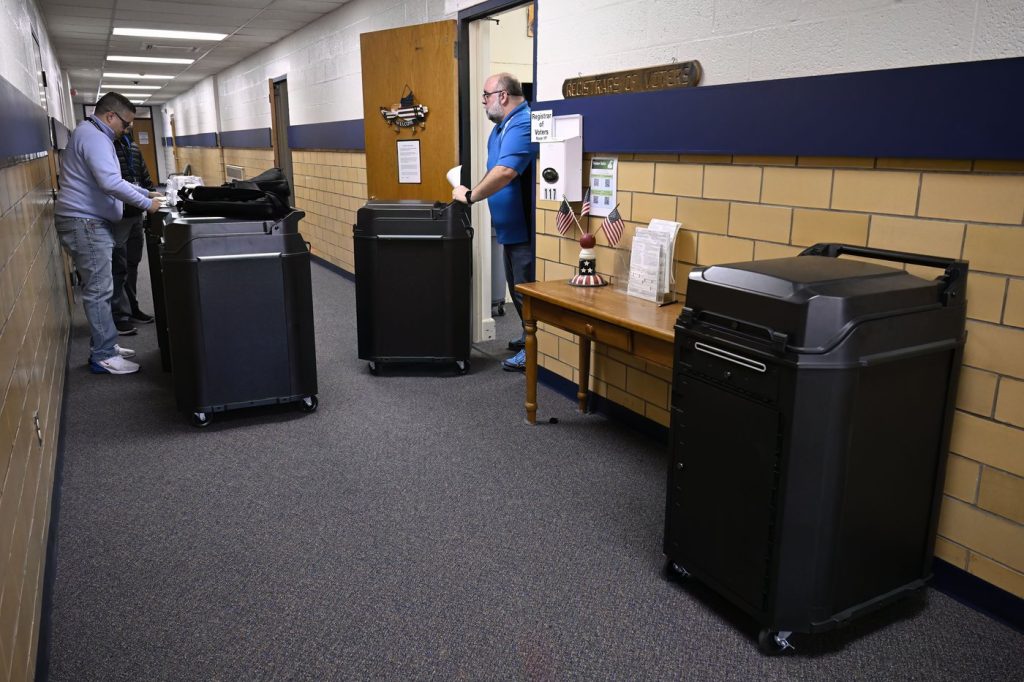ATLANTA (AP) - President Donald Trump’s executive order aimed at changing how U.S. elections are conducted is generating uncertainty among state and local election officials. This has raised concerns about possible voter confusion ahead of the upcoming 2026 midterm elections. Election officials, already facing a reduction in cybersecurity support from the federal government, are now contending with the potential for significant changes. These alterations could include new voter registration requirements, the decertification of certain voting systems, and stricter ballot deadlines for many states.
In Connecticut, Secretary of State Stephanie Thomas expressed her hope that the state’s recent investment of $20 million in ballot scanners will comply with the new executive order. However, she also voiced deeper concerns for other states that may have recently purchased equipment that could become obsolete. “It’s not like states have millions and millions of dollars that they can just upgrade their election equipment every couple of years,” Thomas stated, underlining the financial challenges faced by states in maintaining up-to-date election technology.
The uncertainty surrounding Trump's order is heightened by the likelihood of legal challenges. Many election officials are unsure of the requirements outlined in the order and their respective timelines. Joseph Kirk, who oversees elections in Bartow County, Georgia, remarked, “I hope we have some clarity on some of this stuff soon because no matter what the answers are, I need to take care of my voters.”
In the order issued on a recent Tuesday, Trump criticized the performance of election officials nationwide while praising the electoral processes employed by other countries. He has long raised doubts about the integrity of U.S. elections, continuing to claim that his 2020 electoral defeat to Democrat Joe Biden was the result of a “rigged” election. Despite his assertions, there is no substantive evidence of widespread fraud or manipulations affecting the outcomes, as verified by multiple investigations.
In recent years, many election officials in the U.S. have faced harassment and threats, along with numerous requests from skeptical groups challenging their work. The new executive order exacerbates concerns regarding the federal government’s role in elections, particularly in light of recent decisions that have curtailed federal cybersecurity assistance.
A key aspect of the executive order is the proposed requirement that individuals provide documentary proof of U.S. citizenship when registering to vote. This measure, which had previously been promoted by Republicans in Congress, faced opposition in the Senate. House Republicans are reportedly gearing up to reintroduce legislation known as the Safeguard American Voter Eligibility Act, aiming to address the citizenship verification procedures.
There is significant opposition to the citizenship requirement from voting rights advocates. Critics argue that millions of Americans lack easy access to documentation like birth certificates or passports, and the burden of enforcing these new rules would fall on election officials. David Becker, a former Justice Department lawyer, pointed out that this requirement would create an extensive bureaucracy in every state, complicating the voting process and incurring additional costs without federal funding support.
As election officials gear up for the 2026 elections, there are serious fears about voter confusion stemming from the potential changes. Kate Sweeney Bell, who oversees elections in Indiana's Marion County, expressed concerns about the lack of public knowledge surrounding any potential modifications and the need for robust public education to inform voters. Ryan Macias, an election security expert, emphasized that if election officials are unclear about new rules, it is inevitable voters will be confused, potentially fostering distrust in the electoral process.
Furthermore, Trump’s order targets voting systems to disallow the use of machines with barcodes or QR codes on ballots, except for disability accommodations. This directive could effectively mandate counties to replace their voting machines without any provided funding for these changes, resulting in additional logistical challenges for states.
Experts, such as Mark Lindeman from Verified Voting, have highlighted that procuring and implementing new voting systems is a time-consuming process, which may be complicated further if many states rush to replace their equipment simultaneously. “Last-minute changes or unilateral mandates significantly increase the risk of voter confusion and operational inconsistencies and can erode voter confidence,” remarked Dean Logan, who oversees elections in Los Angeles County. The future of U.S. election integrity remains to be seen amid the backdrop of these substantial uncertainties and changes.










